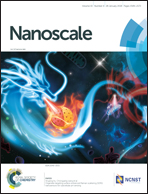Nanoscale chemical imaging of solid–liquid interfaces using tip-enhanced Raman spectroscopy†
Abstract
Tip-enhanced Raman spectroscopy (TERS) is a powerful tool for non-destructive and label-free surface molecular mapping at the nanoscale. However, to date nanoscale resolution chemical imaging in a liquid environment has not been possible, in part due to the lack of robust TERS probes that are stable when immersed in a liquid. In this work, we have addressed this challenge by developing plasmonically-active TERS probes with a multilayer metal coating structure that can be successfully used within a liquid environment. Using these novel TERS probes, we have compared the plasmonic enhancement of TERS signals in air and water environments for both gap mode and non-gap mode configurations and show that in both cases the plasmonic enhancement decreases in water. To better understand the signal attenuation in water, we have performed numerical simulations that revealed a negative correlation between the electric field enhancement at the TERS probe-apex and the refractive index of the surrounding medium. Finally, using these robust probes we demonstrate TERS imaging with nanoscale spatial resolution in a water environment for the first time by employing single-wall carbon nanotubes as a model sample. Our findings are expected to broaden the scope of TERS to a range of scientific disciplines in which nanostructured solid–liquid interfaces play a key role.

- This article is part of the themed collection: 7th EuCheMS Chemistry Congress – Molecular frontiers and global challenges


 Please wait while we load your content...
Please wait while we load your content...